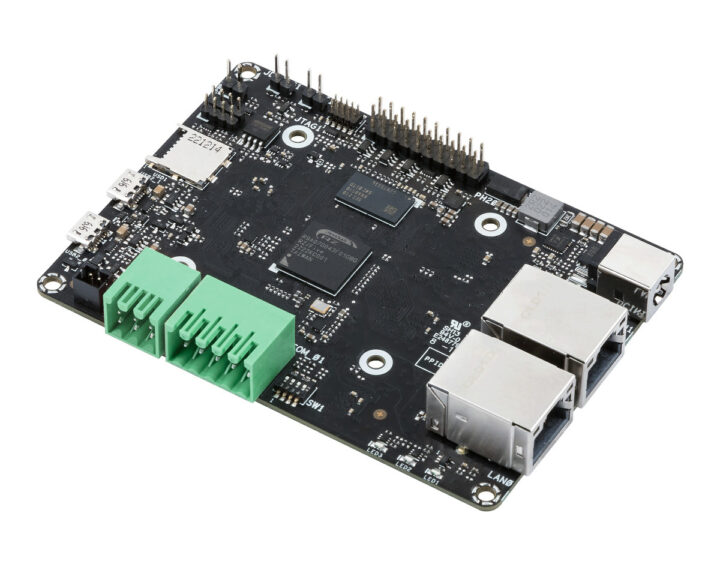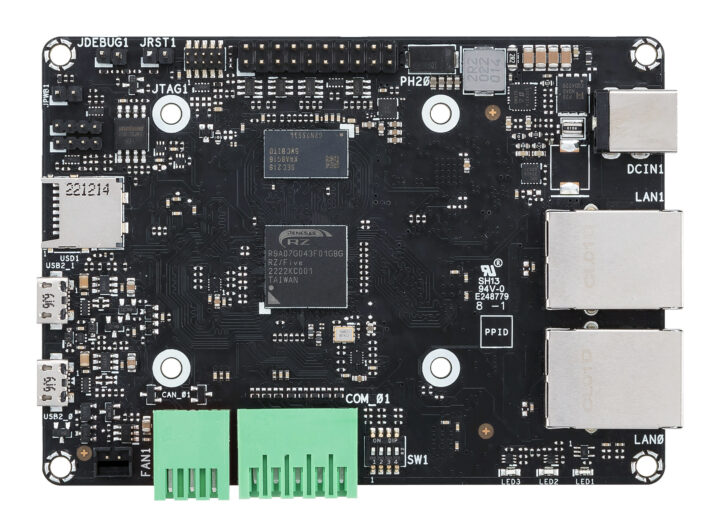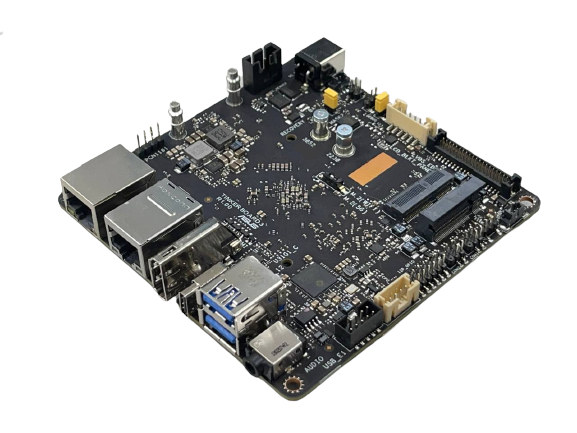ASUS IoT has added two new members to the Tinker board family with the Tinker V and Tinker Board 3 single board computers powered by respectively Renesas RZ/Five single-core RISC-V SoC and Rockchip RK3568 quad-core Arm Cortex-A55 processor.
ASUS Tinker V RISC-V SBC
Tinker V specifications:
- SoC – Renesas RZ/Five single core AndesCore AX45MP RISC-V processor clocked at 1.0 GHz
- System Memory – 1GB DDR4
- Storage – MicroSD card slot, optional 16GB eMMC flash, optional SPI flash
- Networking – 2x Gigabit Ethernet RJ45 ports
- USB – 1x Micro USB port, 1x Micro USB (OTG) port
- Serial –
- 2x CAN Bus via 6-pin terminal block
- 2x COM RS232 via 5-pin terminal block
- Expansion – 20-pin GPIO header with up to 2x UART, 2x I2C, 4x GPIO, 2x ADC, 1x SPI, 3.3V, and GND
- Debugging – JTAG pin header
- Power Supply – 10 to 24V DC via 5.5/2.5 mm DC barrel jack
- Dimensions – Pico-ITX board
- Temperature Range – -20 to +60°C
The Tinker V board runs Linux and is designed for the industrial IoT developer community. The board does not seem to be available just yet, and the documentation is not ready at this stage. More details may be found on the product page.
Tinker Board 3
Tinker Board 3 specifications:
- SoC – Rockchip RK3568 quad-core Arm Cortex-A55 processor with Arm Mali-G52 GPU
- System Memory – 2GB, 4GB, or 8GB LPDDR4/LPDDR4X
- Storage – MicroSD card slot, 16MB SPI flash, optional 32GB or 64Gb eMMC flash
- Display
- 1x HDMI with CEC hardware ready
- 40-pin LVDS dual-link + eDP connector
- 5V panel backlight & control header
- Audio
- 1x 3.5 headphone jack (w/ mic)
- 1x stereo speaker header (4 Ohm, 3W each)
- Digital audio via HDMI
- Connectivity
- 2x RJ45 Ethernet ports
- Optional Wi-Fi / Bluetooth via M.2 E-key 2032 module; default: 802.11 a/b/g/n/ac WiFi 5 & BT 5.0 (2T2R)
- Optional 4G / 5G cellular via M.2 B-Key 3042/3052 module + SIM card slot
- USB
- 1x USB 3.2 Gen1 Type-C OTG port
- 2x USB 3.2 Gen1 Type-A ports
- 2x USB 2.0 interfaces via header
- Serial – CAN Bus 2.0B FD, 2x RS232, 1x RS232/422/485 all via pin header
- Expansion
- M.2 E-Key 2032 socket with PCIe 2.0 x1, USB 2.0
- M.2 B-Key 3042/3052 with PCIe 3.0 x1, USB 3.0, USB 2.0, SIM
- 12-pin GPIO header with up to 2x UART, 1x I2C, 1x SPI, 1x SPDIF, 4x PWM, 2x 8-bit ADC, GND
- Misc
- IR receiver header
- 2-pin Recovery header
- 4-pin Power-on & Reset header
- 3-pin Debug UART header
- 4-pin DC Fan header
- 2-pin RTC Battery header
- Power Supply
- 12 to 24V via 5.5/2.5mm DC barrel jack
- 4-Pin power-in header (also for POE module)
- Dimensions – 100 x 100 mm
- Temperature Range – Operating: -40°C to 85°C; storage: -40°C to 85°C
- Humidity – 10% ~ 85% non-condensing (storage)
- Longevity – 7 years
ASUS IoT will provide Debian 11 and Android 12 images for the Tinker Board 3, as well as support for the Yocto Project, but again the documentation is not available at this stage. The Rockchip RK3568 SBC should not provide any benefits in terms of CPU or GPU performance compared to the ASUS Tinker Board 2S SBC powered by the Rockchip RK3399/OP1 processor, but the new Rockchip processor offers many more interfaces many of which are exposed through the latest Tinker Board 3 board.
The Tinker Board 3 will be integrated into industrial applications such as HMI automation controllers, self-service kiosks, digital signage, and other IIoT applications. The company will also offer PP-101W-3568 and PP-156W-3568 capacitive touch panels respectively 10.1- and 15.6-inch models to help with integration into products. Additional information may be found on the product page.
Via ASUS EW23 press release and Liliputing.

Jean-Luc started CNX Software in 2010 as a part-time endeavor, before quitting his job as a software engineering manager, and starting to write daily news, and reviews full time later in 2011.
Support CNX Software! Donate via cryptocurrencies, become a Patron on Patreon, or purchase goods on Amazon or Aliexpress







